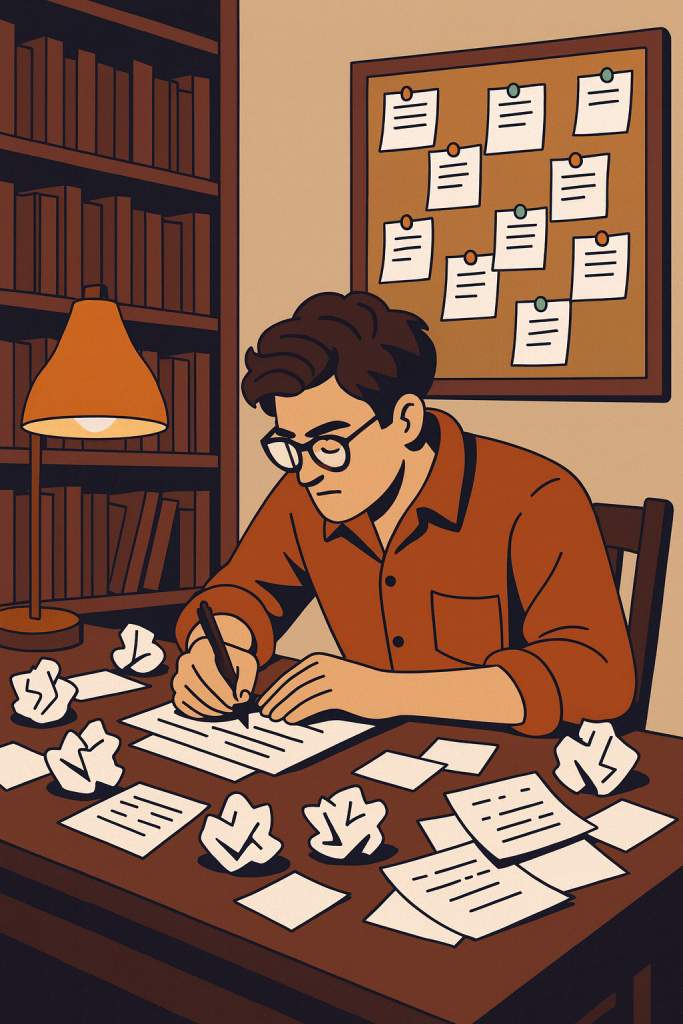Freewriting (sometimes written as “free writing” or “free write”) is a technique where a writer continuously writes for a set period without pausing to edit, evaluate, or censor thoughts. The purpose is to generate ideas freely rather than to produce polished prose. The method was popularized by Peter Elbow in the 1970s as part of his advocacy for writing as a process of discovery rather than mere transcription of preformed ideas.
Unlike brainstorming, which often takes the form of lists or fragments, freewriting unfolds in complete sentences and paragraphs, even if the result is chaotic. The aim is to sustain the flow of language without interruption. Once the timed session ends, the writer revisits the text, then extracts promising thoughts or phrases that may lead to more developed pieces of writing.
Why Writers Use Freewriting
- Overcoming perfectionism and writer’s block: One of freewriting’s greatest strengths is its ability to silence the internal critic. Many writers struggle to begin because they attempt to produce coherent, grammatically sound sentences from the start. Freewriting removes that barrier by setting aside all expectations of correctness. According to studies and writing pedagogy guides, the technique functions like a warm-up exercise that loosens mental constraints before more structured work begins.
- Encouraging divergent thinking and idea fluency: Freewriting also expands the writer’s capacity for divergent thinking—the ability to explore multiple directions and unexpected associations. Research in composition studies shows that students who engaged in focused freewriting produced more original and varied ideas than those who only planned before writing. The continuous movement of thought can reveal associations or images that might otherwise remain submerged beneath self-conscious control.
- Clearing mental clutter: Writers often begin with scattered thoughts or anxieties that obscure clarity. Freewriting provides a release valve: by emptying those thoughts onto the page, the mind clears enough space for creative focus. Many practitioners describe the process as mentally refreshing, an act that relieves tension and creates openness for invention.
- Discovering unexpected material: Because freewriting embraces disorder, it often yields surprising fragments—phrases, metaphors, or ideas—that later become valuable elements in essays, poems, or stories. Writers are encouraged to mine their freewrites after completion then underline passages that possess energy or potential for further development.
How to Freewrite
The Basic Steps
- Set a time limit. Choose a specific duration—often 5, 10, or 15 minutes.
- Optionally choose a focus. Select a word, phrase, or question if you want a general direction, though it is not necessary.
- Write continuously. Begin immediately and keep writing. Do not pause, revise, or judge what appears. If nothing comes to mind, write about that lack until something shifts.
- Stop when time ends. End your session promptly, even mid-sentence.
- Review later. After a break, reread what you wrote and mark sections that seem promising.
Common Variants of Freewriting
- Focused Freewriting: This version confines the session to a single topic or prompt. It suits writers who already have a subject in mind but wish to explore it freely before organizing their arguments or scenes.
- Looping: Peter Elbow introduced “looping” as an iterative form of freewriting. After finishing one session, you select a strong phrase or image from it and begin another timed session centered on that element. Each round refines the thought and guides it toward a clearer shape.
- Extended Freewrites: Some writers prefer longer sessions (twenty minutes or more) to explore complex ideas or emotional states. These extended runs can uncover unexpected patterns or deeper associations, though they demand more stamina and focus.
- Collaborative Freewriting: In classrooms or workshops, participants may freewrite individually, exchange their texts, and then enable others to continue or respond. This collective flow often produces striking juxtapositions and new creative directions.
Tips for Effective Freewriting
- Maintain generosity toward your drafts: Do not expect coherence. Treat your writing session as exploration rather than performance. The primary aim is motion—getting words on paper without restraint.
- Start with manageable durations: If longer sessions feel intimidating, begin with short bursts of two to five minutes and gradually extend the time as the practice becomes habitual.
- Always review what you produce: Though the process values spontaneity, its results grow meaningful only when reviewed. Highlight vivid images, surprising turns, or ideas that could be shaped into essays, poems, or stories.
- Avoid overextension: Excessively long sessions may drift into incoherence, which leaves too much material to sift through. Many writers find ten to twenty minutes optimal for maintaining energy and focus.
- Build a consistent habit: The benefits of freewriting multiply through routine practice. Regular sessions train the mind to enter a state of flow quickly, thereby making creativity more accessible over time.
Applying Freewriting to Productive Writing Projects
Prewriting and Idea Development
Freewriting can serve as an early stage of a project. Before drafting a structured essay, story, or article, writers often freewrite to examine possible themes, perspectives, or emotional tones. The informal language of a freewrite helps surface raw material that later drafts can refine.
Problem-Solving and Revision
When a project reaches a standstill, freewriting about the obstacle itself can restore momentum. Writing openly about confusion, dissatisfaction, or hesitation often clarifies the cause of difficulty. During revision, freewriting about a weak passage or unclear argument can also help uncover what needs to change.
Integration with Other Techniques
Freewriting combines effectively with clustering or mind mapping. You might begin with a visual map of ideas, then use freewriting to elaborate on each node. The process alternates between image and language that promotes creative and analytical thinking to work together.
Academic and Classroom Uses
Teachers often employ focused freewriting in writing instruction to help students organize thoughts and gain fluency. Studies in second-language learning also show that freewriting reduces anxiety about errors and improves spontaneous use of language.
Freewriting as a Path Toward Creative Freedom
Freewriting endures as a cornerstone of the creative process because it gives language space to move before the intellect intervenes. The technique encourages discovery through momentum rather than control. By setting aside judgment, a writer creates conditions for ideas to emerge naturally. Used consistently, freewriting sharpens intuition, expands imaginative range, and strengthens the connection between thought and expression.
Further Reading
‘Don’t think, just write’: How freewriting transformed my thinking by Joshua Glazer, The Emory Wheel
What Is Freewriting? How Writing Without Rules Can Help You Overcome Writer’s Block by Richard Nordquist, ThoughtCo.
The Benefits — and Fun — of Freewriting by Suzanne Mantell, Los Angeles Editors & Writers Group




